Artist/Architect Delivers Art With a View
Step inside Carol and Paul Muldawer's 4,100-square-foot, contemporary Buckhead home in the woods
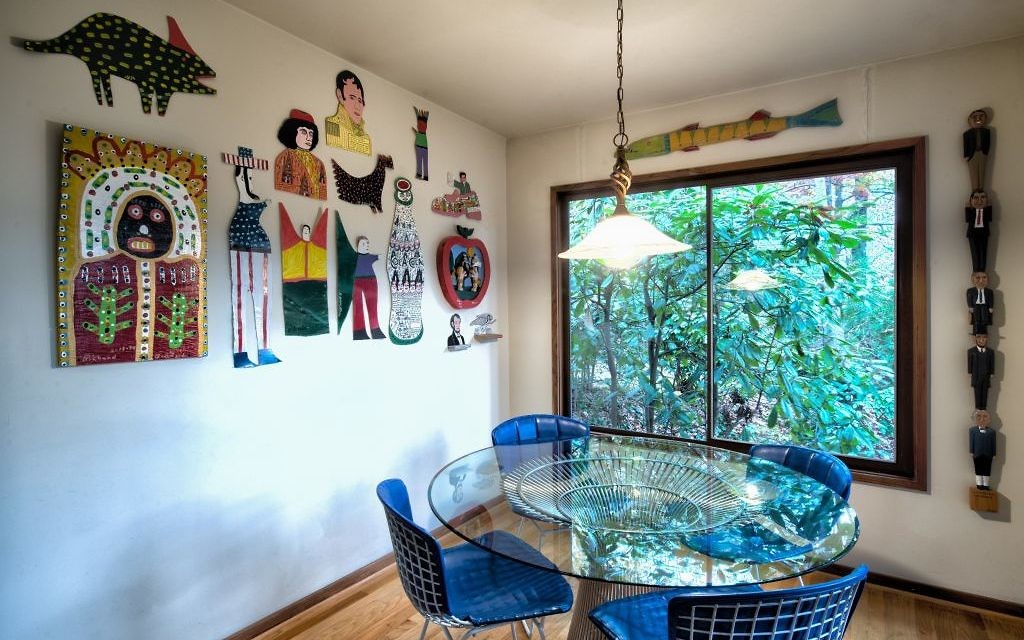
Carol and Paul Muldawer are as colorful and animated as their objets d’art inside.
Paul, an architect since 1962, has specialized in traditional town planning and mixed-use development using the principles of New Urbanism. He is known for designing Atlanta’s City Hall and Annex, Warner Robbins’ City Hall and Civic Auditorium, President Jimmy Carter’s inaugural reviewing facilities, MARTA’s Arts Center station, and the Savannah Historic Preservation Plan.
Carol is no stranger to local politics, with roots back to Andrew Young, for whom she worked as an administrative assistant and photographically documented his career for 20 years. On their walls are two anniversary gifts from Young: a significant work by John Riddle for their 32nd and a rare photograph of Young shinning Muhammad Ali’s shoes in City Hall for their 60th.
Get The AJT Newsletter by email and never miss our top stories Free Sign Up

Carol photographed such notables as Carter, Bill Clinton, Nelson Mandela, Desmond Tutu, Robert McNamara and Coretta Scott King.
Their 4,100-square-foot, contemporary Buckhead home sits in the woods, where slender, horizontal windows beckon light, branches and serenity.
Jaffe: As an architect, what did you envision here?
Paul: I designed our home 50 years ago. It is close to Scandinavian Modern with redwood ceilings in the higher spaces, views of the forest, abundance of natural light, and white walls, which form a neutral background to art and human activity.
In concept, I designed two houses: a children’s house (south side) and a parents’ house (north side), with the dining room as the symbolic center heart. There are spaces for family gathering and for our children to grow independently, with each having their own intimate study carrel.
My design was influenced by the theories of early Renaissance architect Leon Alberti, who said, “A house is a little city. A city is a big house.” The house plan is a microcosm of historic European cities.
In Renaissance cities, the piazza is enclosed by buildings. Here the deck (piazza) is enclosed by three wings and the forest. In Europe, pedestrian streets have vistas that terminate at iconic buildings. Similarly, our hallways provide vistas that terminate at walls on which art is placed; as one moves through the house, surprises and vistas open.
Jaffe: Your folk art is tongue in cheek with a dash of whimsy.
Paul: Not exactly tongue in cheek. Our folk art is serious, honest expressions of feelings and images by untrained artists’ life experiences. We have a mix of folk and modern art.
Carol: Our breakfast room walls are lined with well-known folk artists: Howard Finster, Richard Burnside, R.A. Miller, Tubby Brown, all decades old. They contrast well with the midcentury Platner and Bertoia furniture. By the entrance foyer, we have a three-dimensional, wood, red-white-and-blue collage sculpture of the American flag done eponymously by Ab the Flagman.
One of my living room folk favorites is an aqua table stand by local artist Beth Tarkington titled “Imagine Your Mind as a Garden. What Thoughts Will You Plant There?” The outdoor metal benches are by Pat Juneau. We love the rich salmon and turquoise tones.
Also in the dining room is a handmade wire dress created by folk artist Mr. Imagination, who has works in the High Museum of Art.
Jaffe: What other furniture do we see?
Carol: The living room and den are Thayer Coggin, designed in 1964 by Milo Baughman. The cocktail table is from MoMA. We cherish the handmade wood tables from the Atlanta Crafts Show.
Jaffe: What are some of your most unusual pieces?
Paul: That’s a loaded question. I would say our “Paris Subway” — three-dimensional puppets in a subway observing a couple embracing. Note the real hair and cashmere.
The fireplace copper mobile of ginkgo leaves by Jay Jones is quite graceful by reflecting sunlight in moving, abstract patterns on all walls as it rotates. He hammered each leaf reminiscent of the tree-lined streets of his North Carolina roots.
Carol: In the entry is a sentimental piece symbolizing our family, a fabric appliqué, “Count Your Blessings” by New Orleans artist Chris Roberts-Antieau, stitched with an old-fashioned sewing machine. The dining room Dresden china piece with three tiers and a baby doll head by Deborah Nail is very eclectic. We spotted that at the St. Philip’s Cathedral art show.
Much of what we have are very collectible artists: Robert Motherwell, George Segal, Yaacov Agam, Ed Moulthrop, Herb Creecy, Josef Albers, and Charles Mitchell, a very accomplished sculptor who taught at our High Museum.
Jaffe: Which came first — chicken or egg? Are you an artist or an architect at heart?
Paul: I am both and try to continue to live a creative life.
The entire lower level is my studio and workshop. I have taken over 13,000 photographs from travels. From these, I paint photo realism on recycled wood with watercolor, which allows controllable opacity. Carol has a studio on our second level accessed by a metal spiral staircase, where she keeps her collection of celebrity photographs taken over the years using film cameras.

In the den is my 1957 painting “Stuttgart,” done when I was a radio operator in the U.S. Army in Germany. Later, at the University of Pennsylvania, while studying under Louis Kahn, I entered that painting at the Penn Art Show, which won first prize. In the studio, you will see over 50 works of art: conventional paintings, three-dimensional paintings, photography, and my latest work, kinetic three-dimensional photo montages.
Jaffe: What advice would you give to young couples building their first home?
Paul: Find a young, talented architect who is more interested in design than profit.
Jaffe: Easier said than done. Are you finished collecting? If you could wake up tomorrow and find a new piece here, what would it be?
Paul: Heck, no, I’m not finished. Carol and I would like a Brancusi sculpture. “Bird in Space” would do.
Photos by Duane Stork
-
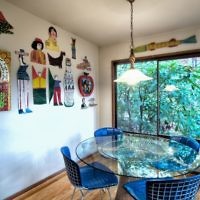
- Folk art by Finster, Burnside, Miller and Brown creates a contrast with the midcentury furniture by Platner and Bertoia inside Carol and Paul Muldawer’s woodsy Buckhead home. All photos by Duane Stork.
-

- Paul Muldawer makes good use of his lower-level workshop, where he stores no fewer than 13,000 photos for future projects.
-
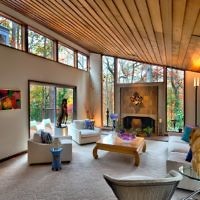
- Folk art by Finster, Burnside, Miller and Brown creates a contrast with the midcentury furniture by Platner and Bertoia.



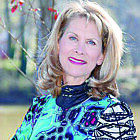




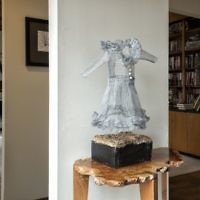
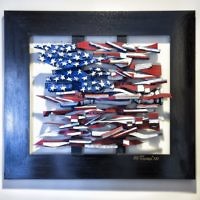
comments